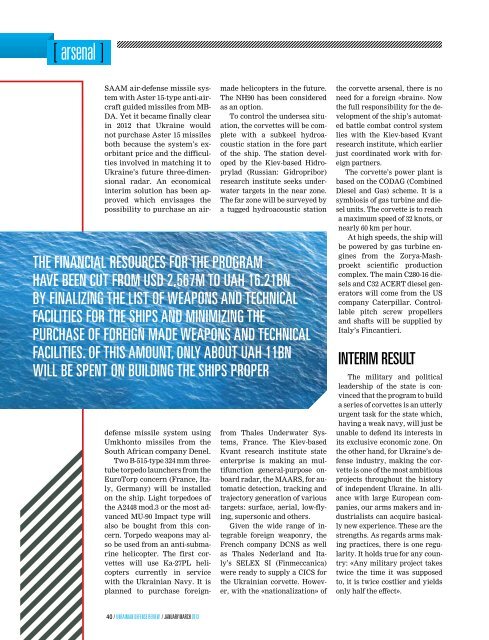National Capabilities
Ukrainian defense industry is comprised of enterprises of various patterns of ownership which are subordinated to different government agencies, which already participate in government contracts relating to the State Defense Procurement Order, and which are directly involved in or perform sub-contracted works under Ukraine’s international military cooperation programs.
Ukrainian defense industry is comprised of enterprises of various patterns of
ownership which are subordinated to different government agencies, which
already participate in government contracts relating to the State Defense
Procurement Order, and which are directly involved in or perform sub-contracted
works under Ukraine’s international military cooperation programs.
Create successful ePaper yourself
Turn your PDF publications into a flip-book with our unique Google optimized e-Paper software.
[ arsenal ]<br />
SAAM air-defense missile system<br />
with Aster 15-type anti-aircraft<br />
guided missiles from MB-<br />
DA. Yet it became finally clear<br />
in 2012 that Ukraine would<br />
not purchase Aster 15 missiles<br />
both because the system’s exorbitant<br />
price and the difficulties<br />
involved in matching it to<br />
Ukraine’s future three-dimensional<br />
radar. An economical<br />
interim solution has been approved<br />
which envisages the<br />
possibility to purchase an air-<br />
defense missile system using<br />
Umkhonto missiles from the<br />
South African company Denel.<br />
Two B-515-type 324 mm threetube<br />
torpedo launchers from the<br />
EuroTorp concern (France, Italy,<br />
Germany) will be installed<br />
on the ship. Light torpedoes of<br />
the A2448 mod.3 or the most advanced<br />
MU-90 Impact type will<br />
also be bought from this concern.<br />
Torpedo weapons may also<br />
be used from an anti-submarine<br />
helicopter. The first corvettes<br />
will use Ka-27PL helicopters<br />
currently in service<br />
with the Ukrainian Navy. It is<br />
planned to purchase foreign-<br />
40 / Ukrainian DEFEnSE rEViEW / JanUary-MarCH 2013<br />
made helicopters in the future.<br />
The NH90 has been considered<br />
as an option.<br />
To control the undersea situation,<br />
the corvettes will be complete<br />
with a subkeel hydroacoustic<br />
station in the fore part<br />
of the ship. The station developed<br />
by the Kiev-based Hidroprylad<br />
(Russian: Gidropribor)<br />
research institute seeks underwater<br />
targets in the near zone.<br />
The far zone will be surveyed by<br />
a tugged hydroacoustic station<br />
the fINANCIAl ResoURCes foR the pRogRAM<br />
hAVe BeeN CUt fRoM Usd 2,567M to UAh 16.21BN<br />
By fINAlIzINg the lIst of WeApoNs ANd teChNICAl<br />
fACIlItIes foR the shIps ANd MINIMIzINg the<br />
pURChAse of foReIgN MAde WeApoNs ANd teChNICAl<br />
fACIlItIes. of thIs AMoUNt, oNly ABoUt UAh 11BN<br />
WIll Be speNt oN BUIldINg the shIps pRopeR<br />
from Thales Underwater Systems,<br />
France. The Kiev-based<br />
Kvant research institute state<br />
enterprise is making an multifunction<br />
general-purpose onboard<br />
radar, the MAARS, for automatic<br />
detection, tracking and<br />
trajectory generation of various<br />
targets: surface, aerial, low-flying,<br />
supersonic and others.<br />
Given the wide range of integrable<br />
foreign weaponry, the<br />
French company DCNS as well<br />
as Thales Nederland and Italy’s<br />
SELEX SI (Finmeccanica)<br />
were ready to supply a CICS for<br />
the Ukrainian corvette. However,<br />
with the «nationalization» of<br />
the corvette arsenal, there is no<br />
need for a foreign «brain». Now<br />
the full responsibility for the development<br />
of the ship’s automated<br />
battle combat control system<br />
lies with the Kiev-based Kvant<br />
research institute, which earlier<br />
just coordinated work with foreign<br />
partners.<br />
The corvette’s power plant is<br />
based on the CODAG (Combined<br />
Diesel and Gas) scheme. It is a<br />
symbiosis of gas turbine and diesel<br />
units. The corvette is to reach<br />
a maximum speed of 32 knots, or<br />
nearly 60 km per hour.<br />
At high speeds, the ship will<br />
be powered by gas turbine engines<br />
from the Zorya-Mashproekt<br />
scientific production<br />
complex. The main C280-16 diesels<br />
and C32 ACERT diesel generators<br />
will come from the US<br />
company Caterpillar. Controllable<br />
pitch screw propellers<br />
and shafts will be supplied by<br />
Italy’s Fincantieri.<br />
INteRIM ResUlt<br />
The military and political<br />
leadership of the state is convinced<br />
that the program to build<br />
a series of corvettes is an utterly<br />
urgent task for the state which,<br />
having a weak navy, will just be<br />
unable to defend its interests in<br />
its exclusive economic zone. On<br />
the other hand, for Ukraine’s defense<br />
industry, making the corvette<br />
is one of the most ambitious<br />
projects throughout the history<br />
of independent Ukraine. In alliance<br />
with large European companies,<br />
our arms makers and industrialists<br />
can acquire basically<br />
new experience. These are the<br />
strengths. As regards arms making<br />
practices, there is one regularity.<br />
It holds true for any country:<br />
«Any military project takes<br />
twice the time it was supposed<br />
to, it is twice costlier and yields<br />
only half the effect».

















